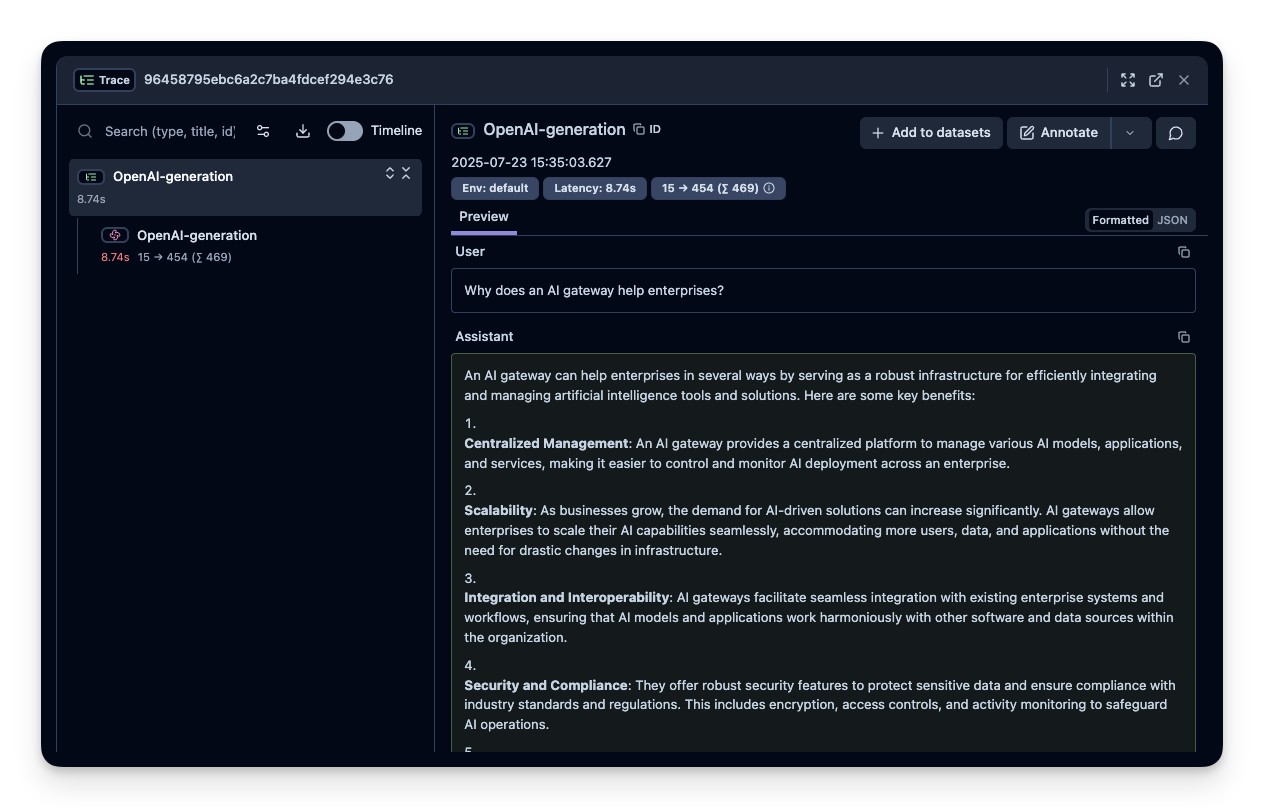TrueFoundry AI Gateway Integration
What is Truefoundry? TrueFoundry is an enterprise-grade AI Gateway and control plane that lets you deploy, govern, and monitor any LLM or Gen-AI workload behind a single OpenAI-compatible API—bringing rate-limiting, cost controls, observability, and on-prem support to production AI applications.
How Truefoundry Integrates with Langfuse
Truefoundry’s AI Gateway and Langfuse combine to give you enterprise-grade observability, governance, and cost control over every LLM request—set up in minutes.
Unified OpenAI-Compatible Endpoint
Point the Langfuse OpenAI client at Truefoundry’s gateway URL. Truefoundry routes to any supported model (OpenAI, Anthropic, self-hosted, etc.), while Langfuse transparently captures each call—no code changes required.
End-to-End Tracing & Metrics
Langfuse delivers:
- Full request/response logs (including system messages)
- Token usage (prompt, completion, total)
- Latency breakdowns per call
- Cost analytics by model and environment
Drill into any trace in seconds to optimize performance or debug regressions.
Production-Ready Controls
Truefoundry augments your LLM stack with:
- Rate limiting & quotas per team or user
- Budget alerts & spend caps to prevent overruns
- Scoped API keys with RBAC for dev, staging, prod
- On-prem/VPC deployment for full data sovereignty
Prerequisites
Before integrating Langfuse with TrueFoundry, ensure you have:
- TrueFoundry Account: Create a Truefoundry account with atleast one model provider and generate a Personal Access Token by following the instructions in quick start and generating tokens
- Langfuse Account: Sign up for a free Langfuse Cloud account or self-host Langfuse
Step 1: Install Dependencies
%pip install openai langfuseStep 2: Set Up Environment Variables
Next, set up your Langfuse API keys. You can get these keys by signing up for a free Langfuse Cloud account or by self-hosting Langfuse. These environment variables are essential for the Langfuse client to authenticate and send data to your Langfuse project.
import os
# Langfuse Configuration
os.environ["LANGFUSE_PUBLIC_KEY"] = "pk-lf-..."
os.environ["LANGFUSE_SECRET_KEY"] = "sk-lf-..."
os.environ["LANGFUSE_BASE_URL"] = "https://cloud.langfuse.com" # 🇪🇺 EU region
# os.environ["LANGFUSE_BASE_URL"] = "https://us.cloud.langfuse.com" # 🇺🇸 US region
# TrueFoundry Configuration
os.environ["TRUEFOUNDRY_API_KEY"] = "your-truefoundry-token"
os.environ["TRUEFOUNDRY_BASE_URL"] = "https://your-control-plane.truefoundry.cloud/api/llm"from langfuse import get_client
# Test Langfuse authentication
get_client().auth_check()True
Step 3: Use Langfuse OpenAI Drop-in Replacement
Use Langfuse’s OpenAI-compatible client to capture and trace every request routed through the TrueFoundry AI Gateway. Detailed steps for configuring the gateway and generating virtual LLM keys are available in the TrueFoundry documentation.
from langfuse.openai import OpenAI
import os
# Initialize OpenAI client with TrueFoundry Gateway
client = OpenAI(
api_key=os.environ["TRUEFOUNDRY_API_KEY"],
base_url=os.environ["TRUEFOUNDRY_BASE_URL"] # Base URL from unified code snippet
)Step 4: Run an Example
# Make a request through TrueFoundry Gateway with Langfuse tracing
response = client.chat.completions.create(
model="openai-main/gpt-4o", # Paste the model ID you copied from TrueFoundry Gateway
messages=[
{"role": "system", "content": "You are a helpful AI assistant specialized in explaining AI concepts."},
{"role": "user", "content": "Why does an AI gateway help enterprises?"},
],
max_tokens=500,
temperature=0.7
)
print(response.choices[0].message.content)
# Ensure all traces are sent to Langfuse
langfuse = get_client()
langfuse.flush()Step 5: See Traces in Langfuse
After running the example, log in to Langfuse to view the detailed traces, including:
- Request parameters
- Response content
- Token usage and latency metrics
- LLM model information through Truefoundry gateway

Note: All other features of Langfuse will work as expected, including prompt management, evaluations, custom dashboards, and advanced observability features. The TrueFoundry integration seamlessly supports the full Langfuse feature set.
Advanced Integration with Langfuse Python SDK
Enhance your observability by combining the automatic tracing with additional Langfuse features.
Using the @observe Decorator
The @observe() decorator automatically wraps your functions and adds custom attributes to traces:
from langfuse import observe, get_client, propagate_attributes
langfuse = get_client()
@observe()
def analyze_customer_query(query, customer_id):
"""Analyze customer query using TrueFoundry Gateway with full observability"""
# Propagate attributes to all child observations
with propagate_attributes(
user_id=customer_id,
session_id=f"session_{customer_id}",
tags=["customer-service", "truefoundry-gateway"],
metadata={"gateway": "truefoundry"},
version="1.0.0"
):
response = client.chat.completions.create(
model="openai-main/gpt-4o",
messages=[
{"role": "system", "content": "You are a customer service AI assistant."},
{"role": "user", "content": query},
],
temperature=0.3
)
result = response.choices[0].message.content
# update trace level input and output
langfuse.update_current_trace(
input={"query": query, "customer_id": customer_id},
output={"response": result},
)
return result
# Usage
result = analyze_customer_query("How do I reset my password?", "customer_123")Debug Mode
Enable debug logging for troubleshooting:
import logging
logging.basicConfig(level=logging.DEBUG)Note: All other features of Langfuse will work as expected, including prompt management, evaluations, custom dashboards, and advanced observability features. The TrueFoundry integration seamlessly supports the full Langfuse feature set.
Learn More
- TrueFoundry AI Gateway Introduction: https://docs.truefoundry.com/gateway/intro-to-llm-gateway
- TrueFoundry Authentication Guide: https://docs.truefoundry.com/gateway/authentication
Interoperability with the Python SDK
You can use this integration together with the Langfuse SDKs to add additional attributes to the trace.
The @observe() decorator provides a convenient way to automatically wrap your instrumented code and add additional attributes to the trace.
from langfuse import observe, propagate_attributes, get_client
langfuse = get_client()
@observe()
def my_llm_pipeline(input):
# Add additional attributes (user_id, session_id, metadata, version, tags) to all spans created within this execution scope
with propagate_attributes(
user_id="user_123",
session_id="session_abc",
tags=["agent", "my-trace"],
metadata={"email": "user@langfuse.com"},
version="1.0.0"
):
# YOUR APPLICATION CODE HERE
result = call_llm(input)
# Update the trace input and output
langfuse.update_current_trace(
input=input,
output=result,
)
return resultLearn more about using the Decorator in the Langfuse SDK instrumentation docs.
Next Steps
Once you have instrumented your code, you can manage, evaluate and debug your application: